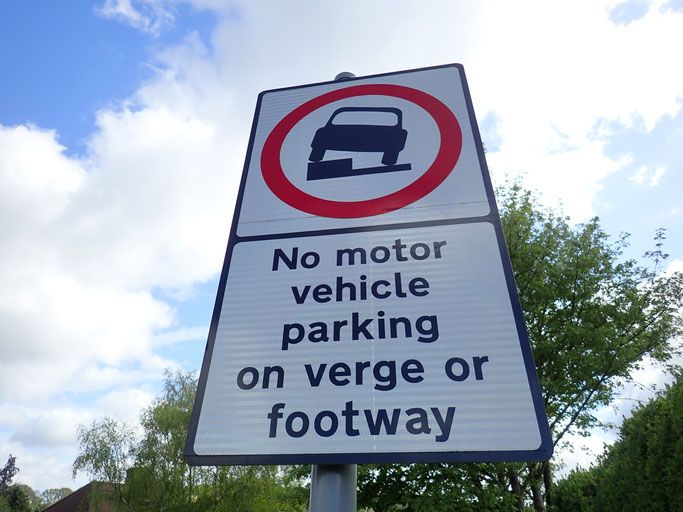
As the government promises yet another consultation into pavement parking, we’re left wondering whether this anti-social and dangerous behaviour will ever be dealt with.
As well as being a menace for the disabled, elderly and vulnerable, pavement parking is a downright nuisance for everyone. On top of that, it damages footways and is a visual eyesore.
With the exception of London – where a ban already exists – only lorries are currently prevented from parking on pavements. The solution to pavement parking isn’t endless consultations, public information campaigns or silly gimmicks, it’s a simple change to the law to allow local authorities to enforce the obvious: Pavements are for people.
The reluctance of government to deal with pavement parking may be due in part to lobbying by the motoring lobby. The AA described talk of nationwide ban on pavement parking as ‘a step too far’ and a recipe for parking chaos. However, campaign groups are determined to see a change in the law.
To help keep the topic on the news agenda, we devised a fictional device designed to be installed along kerbs that quickly punctures tyres.
Catclaw is the size of half a small orange and was designed to be installed in its thousands along kerbs and pavements. When a car or lorry drives over a CatClaw, its weight exposes a sharp steel tube that quickly punctures the tyre. However, it poses no threat to pedestrians – a person standing on top of the device would not be heavy enough to activate it.

If a car mounts a pavement fitted with Catclaw, it’s tyres are quickly and efficiently burst

The Catclaw is an extreme idea that is unlikely to be practicable, or even legal. Other than the sharpened spike hidden within, what, you may ask, is it’s point. The purpose of the project is to highlight the plight of the 43 people killed last year on pavements in Britain by drivers and the many thousands of pedestrians every day who have their path blocked.
The Catclaw served as a Trojan horse that allowed us to talk at some length about the need to radically alter the way we tackle road danger in all its forms. The project has appeared on television and in The Daily Mail, The Express, The Mirror, Metro, The Manchester Evening News and been viewed over 120,000 times on YouTube.
The systematic approach to road danger reduction Britain so badly needs will not involve Catclaw or anything remotely as outlandish. As has happened in countries such as Sweden, it involves placing needs of people ahead of cars. The benefits are numerous, but include safer roads, reduced healthcare costs, greater independence for children and increased quality of life for all. However, change of this kind can occur only once people – as opposed to politicians – consider it vital. And that process starts with getting it talked about. Please watch the film we made about road danger and share.
The work of the ETA ranges from awareness-raising projects like the Catclaw and the film above, to community roadshows promoting sustainable transport and helping schools mount protests to demand safer road crossings. Supporting these projects is easy. Simply buy your home insurance, cycle insurance, travel insurance and breakdown cover and you will be helping to fund these projects and many more besides. And you can rest assured that by choosing us you will not be compromising on quality or paying over the odds – we’ve been around for 30 years and are rated as Britain’s most ethical choice by The Good Shopping Guide.

Mara Ozolins
I can see the issue with unnecessary pavement parking, but it can be a necessary evil. In my area many of the houses are without drives and, because the roads are narrow, if people did not park partly on the pavement there would not be room for cars to drive past, never mind bin lorries, ambulances etc. People with limited mobility need to park directly outside their house, and in any case there would not be anywhere else locally for people to park; limiting parking to one side of the road would not leave enough space. Most cars park considerately with room for buggies, mobility scooters etc to get past. A blanket ban just wouldn’t work; it has to be tailored to the particular road.
edmund white
It would seem the catclaw maybe the only way to end pavement parking. We have laws that should control it, but they are not enforced, another new law , unless enforced will not do any better Shame that drivers only seem to learn when it hurts, never mind the pain they cause others.
Vincent Edwards
I’ve just been reading on-line comments following a “Telegraph” article about the proposed “criminalisation” of pavement parking, a move which the author opposes. She misses the point. The proposal is actually to decriminalise pavement parking and give control to local authorities – Police are rarely interested. There will be exemptions for areas where parking is particularly tight.
Some commentators support the proposed legislation. But there are the inevitable predictable comments; “just a scheme to make money”, “I considerately park on the pavement so emergency vehicles can get past”, “so long as I leave room for a buggy what is there to complain about?” , “what about cycling on pavements?” “what about the wheelie bins?” – to the latter two comments I would say “yes, we have to put up with that as well as your inconsiderately parked car”.
Most of the pavement parking I see takes place in locations where there are plenty of alternatives, though admittedly some involve a very short walk or having to turn the steering wheel a bit – on my local housing estate parking bays lie empty while the pavements are blocked by parked cars. Some park on the pavement across the entrance to their empty driveways.
Thanks to unrestricted pavement parking some motorists have got so used to driving on the pavement that they mount it routinely and at speed to avoid an obstruction, such as a vehicle making a right turn in front of them. Parents used to warn children to be careful crossing the road. Now they have to be careful walking on the pavement.
I could go on about the horrors of school run time, or the utter lack of enforcement of existing legislation – but that’ll do for now. I just hope the government has the guts to take effective action. I am not holding my breath.
Gary McMahon
As we have seen from the ludicrous anger from motorists aimed at cyclists we will never improve these type of issues when the majority of the people are so embedded in the car culture. Even otherwise considerate people put their rights to car driving, parking, etc above the needs of those who are stupid enough to be outside the safety of their metal caves.
Val Harris
What I would really like is to have access to a leaflet I could download and place under car windscreens where they block the pavement. Does anything exist?
Cynthia Floud
We invented such a card for our village.
Vincent Edwards
Mara’s argument is always the first to be raised when a ban on pavement parking is discussed (closely followed by “what about cyclists?”, “what about wheelie bins?” and “what about overgrown hedges?”) Legislation proposed by the Select Committee suggests that local authorities be allowed to make special arrangements for the type of streets she describes. It is impossible to please everyone. For decades the authorities have looked the other way while the pavements have become unofficial car parks.
We need to limit and control pavement parking in areas such as those described by Mara – giving pedestrians a chance may cause some disruption to motorists, but as ever more households acquire multiple cars they will in any case find themselves running out of pavements to park on.
Elsewhere – for example post-war suburban estates where everyone has room to park in their front garden – prohibit pavement parking entirely. Why do I feel so strongly? Well my mother lives on such an estate. She’d like to use her mobility scooter but can’t because the pavements are blocked. Cars on both pavements leave insufficient room between them for a fire engine to get through.
Without clear legislation and firm enforcement I shudder to think where this is going.